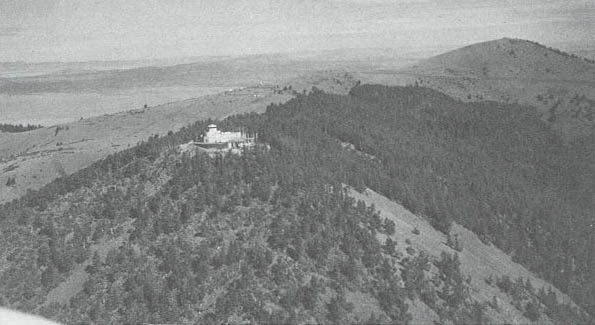1
The View From A Height
|
|||
|
Langmuir Laboratory on remote South Baldy. New Mexico Tech Archives. |
|||
The ridge extending from South Baldy, a 10,700-foot peak in New Mexico's Cibola National Forest, is about the last place anyone would look for a five-story building. But there it is: green, rectangular, and bristling with antennas, overlooking the seven miles of primitive road leading up to it. Next door is another building, a round one, topped by what looks like an airport control tower.
The rectangular building, the Annex of the Langmuir Laboratory for Atmospheric Research, also has an observation tower on top. In the early morning sun, both towers offer a fine view of the white antennas of the Very Large Array radiotelescope spread out in a giant Y, thirteen miles on a side, across the Plains of San Agustin to the west. By night, Albuquerque is a lake of golden light in the middle distance, Santa Fe a glittering jewel on the northern horizon. The light spills down the Rio Grande Valley to Socorro and trickles away into the desert to the south.
But on this August afternoon, no one at Langmuir is looking at the scenery. Scientists and their assistants are finishing their lunches and looking for raincoats and walkie-talkies. The cumulonimbus cloud overhead is getting bigger and darker, signaling that is it time to go to work.
On a chart recorder in the observation tower atop the Annex, the fair-weather meanderings of the electric-field readings cross the center lines of their tracks, smoothing out and veering off into the foul-weather zone. In a blacked-out room one floor below, a student watches a pair of green radarscopes, his face bathed in their eerie glow as he monitors the growth of the storm. At the Socorro airport, seventeen miles away, a powered sailplane takes off on a mission to penetrate the cloud.
The stately tick of the chart recorders becomes a rattle as the tower operator puts them on high speed. Along the ridge, activity grows like the cloud itself. More radars are warmed up and put in operation. A tethered balloon carries instruments into the cloud base. As the first raindrops streak the windows, the plane buzzes down Sawmill Canyon, climbing past the lab into the cloud.
|
|
|
Closeup of laboratory. Jack B. Pearce Photograph. |
Two-way radios crackle with reports on the storm's growth as the rain falls harder and the electric fields become stronger. At the very top of South Baldy, the metal doors of two underground steel bunkers--Kivas I and II--are closed, Inside the kivas, scientists check their instruments and wait for the electric fields to build even higher. An array of small rockets stands ready atop one of the kivas.
The electric fields grow: six kilovolts per meter (kV/m, pronounced kay-vee-em) then seven, then eight. A man in his sixties with crewcut and green jumpsuit climbs into the tower. Energized by the excitement, he picks up the radio mike and reports personally on what the radarscopes revealed.
Eight point five kVm. The plane is safely away from the lab. The ground personnel are at their posts. Radars and cameras are trained on the peak as the fields pass nine kV/m and a woman's voice comes over the radio: "Langmuir Lab, this is the Kiva. Request a five-minute window for firing."
Crewcut nods his assent. "Five-minute window open 1335," replies the tower operator, who gives a warning blast on a siren. A lightning strike on Timber Ridge, on the other side of the canyon, discharges the fields, which quickly build again: nine kV/m, ten, ten five. A potential difference of ten thousand five hundred volts between the floor and a person's belt buckle.
"Langmuir Lab, we will fire in five seconds.
"Four.
"Three.
"Two.
"One.
"Fire!"
A streak of black smoke arcs into the murk from the top of the Kiva. Just as the hollow whoosh of the rocket reaches the lab, a column of light streaks from the cloud to the Kiva. The crack and roll of thunder mingles with the whoops and yells of onlookers as the operator confirms the triggered stroke.
To be sure, thunderstorm research means solving equations, interpreting data, and looking up references in the library. But during the few weeks of storm season at Langmuir, it means other things. It means standing on the roof while corona current sings from the antennas, then hustling back into the tower seconds before lightning strikes so close there is no thunder. It means firing a rocket from the Kiva and waiting underground for tens of thousands of amperes--and only God knows how many millions of volts--to go to ground through the steel roof. And it also means nights of quiet solitude for those who live at the lab, with the rest of the world a glittering insignificance far below.
Some people don't last a single summer at the lab; others build their careers there.
In many ways, the science of atmospheric physics, which gave birth to this lab on top of a mountain, can be traced back to Benjamin Franklin. Some of its more fanciful practitioners look back even further, to the Roman Lucretius, or even to the Book of Exodus. But many atmospheric physicists--certainly the ones in New Mexico--like to place the beginnings of their discipline in 1935, when a physicist named E. J. Workman began his studies of clouds and lightning. The lab itself got its start in 1961, largely because of the efforts of Dr. Workman.
Next: Chapter 2 - The Early Days
Previous: Preface


